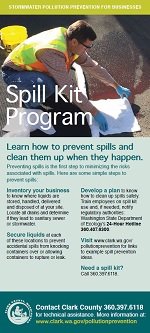Surface cleaning
Pressure washing can contribute to water pollution
if runoff enters storm drains.
Cleaning projects can create contaminated runoff that pollute our streams and rivers after entering the storm sewer via storm drains. Contaminants include soaps, oil and grease, dirt, and whatever else the cleaning project is washing off such as pet waste, vehicle grime, moss and other oraganic material. Cleaning includes pressure washing, hand washing, scrubbing, or sanding and pollution can come from:
- Cleaning commmerical vehicles or industrial equipment
- Outdoor surface cleaning with high or low-pressure
- Restaurant kitchens
- Carpet cleaning
- Car wash fundraisers
Ensure your cleaning projects aren't sending pollutants to our streams and rivers. Following Best Management Practices (BMPs) can prevent pollution, saving your business time and money while protecting water and avoiding regulatory enforcement.
En Español - на русском
Pollution control BMPs
A worker collects discharge water before it enters
the storm drain
Conduct cleaning activities inside a building, if possible. Inside drains go to the sanitary sewer (see contact information below) which is treated, but water entering outside storm drains do not get treated before discharing to streams.
Contain the cleaning activity.
Ask your local jurisdiction about fundraiser carwash kits for loan.
Use berms, dams or drain plugs to prevent polluted dishcharge from entering storm drains.
This car wash kit prevents soapy water from
entering the storm drain, adding another good
cause to the fundraising event.
Collect discharge water before it enters storm drains and empty into sanitary sewer (with approval from the local sewer authority).
Keep these materials out of sanitary sewers AND storm drains:
- F.O.G. - Fats, Oils and Grease
- Non-dispersible materials such as rags, food, latex, personal hygiene products, or cleaning wipes. Dispose of this material in the trash.
- Hazardous materials or hazardous waste
- Pharmaceuticals
Questionable materials? Check with your sewer authority
Some commercial and industrial wastewater discharges other than domestic wastewater may require pretreatment and/or an industrial wastewater discharge permit. Check with your sewer authority before discharging questionable materials.
City of Camas Sewer Department - call 360-817-1567 or visit the website
City of Vancouver - call 360-487-7130 or visit the Pretreatment Program website
City of Washougal - call 360-835-2662 ext 220 or visit the website
Clark Regional Wastewater (unincorporated Clark County, Battle Ground, and Ridgefield) - call 360-993-8833 or visit the website
Limpieza de superficies
¿Los proyectos de limpieza contaminan nuestros arroyos y ríos? Proteja los arroyos, los ríos y el agua subterránea siguiendo estas mejores prácticas al lavar en exteriores:
La contaminación puede provenir de:
• Lavado comercial de vehículos
• Cocinas de restaurantes
• Alfombras
• Equipo industrial
• Edificios con agua de baja o alta presión.
• Lavados de autos para recaudar fondos
La limpieza puede incluir: lavar a presión, lavar a mano, restregar, lijar, entre otras cosas.
A menos que sea agua limpia, mantenga el agua residual alejada de los drenajes pluviales. El agua de lavado incluye jabón, detergente, tierra y grasa, los cuales contaminan.
Las medidas de control de contaminación incluyen:
• Realizar la actividad dentro de un edificio.
• Contener la actividad de limpieza.
• Recolectar agua para descargas.
• Enviar el agua de lavado a un desagüe sanitario (con la aprobación de la autoridad de alcantarillado local).
• Mantener el agua contaminada lejos de los drenajes pluviales y evitar que fluya a vías navegables superficiales o que se infiltre en la tierra.
Evite la descarga de contaminantes utilizando tapones de drenajes, diques o terraplenes.
Очистка поверхности
Загрязняют ли проекты по очистке наши ручьи и реки? Придерживаясь следующих наиболее эффективных методов, вы защитите ручьи, реки и грунтовые воды, проводя мойку вне дома:
Причиной загрязнения может быть:
• Промышленная мойка автомобилей
• Кухни ресторанов
• Ковры
• Промышленное оборудование
• Постройки с водой под высоким или низким давлением.
• Мойки автомобилей для сбора средств
Уборка может включать мойку под давлением, ручную мойку, очистку скребком, песком и т. д.
Если вода загрязнена, не сливайте ее в ливневую канализацию. Смывная вода содержит мыло, моющие средства, грязь и жир, являющиеся загрязнителями.
Меры по защите окружающей среды включают:
• Проведение работ внутри зданий.
• Ограничение деятельности по очистке.
• Сбор отработанной воды.
• Слив воды, использованной для мытья, в бытовую канализацию (с разрешения соответствующих местных органов).
• Недопущение попадания загрязненных вод в ливневую канализацию и предотвращение их попадания в поверхностные водостоки или проникновения в почву.
Предотвращайте сброс загрязнителей с помощью сливных пробок, дамб или уступов.







